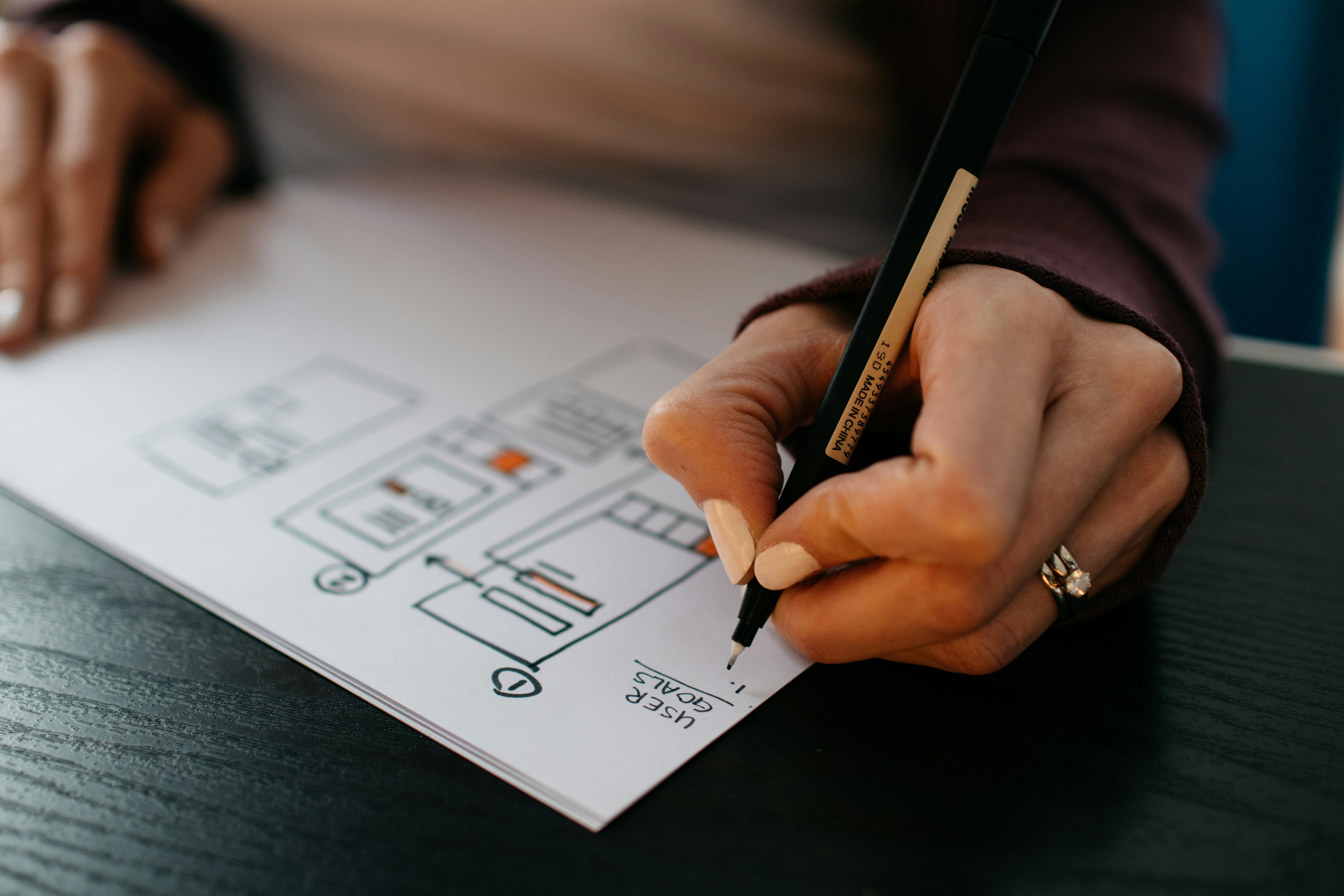Table of Contents
- From zero to UX design freelancer
- 9 steps to win the first freelance client as UX designer
- 1. Start with a killer portfolio
- 5 tips to craft a killer portfolio:
- 2. Network like a pro
- 🔸 Online networking
- 🔸 In-person networking
- 3. Leverage freelancing platforms
- 🔸 Marketplaces
- 🔸 Job boards
- 4. Create content and share your knowledge
- Which platform should you choose?
- Effective content strategies for UX designers:
- 5. Ask for referrals and testimonials
- 🔸 Referrals
- 🔸Testimonials
- 6. Offer a free workshop or consultation
- 🔸 Workshops
- 🔸 Consultations
- 7. Stay organized and professional
- 🔸 Client management
- 🔸 Project management
- 8. Price your services wisely
- Three classic pricing mistakes:
- 9. Be persistent and patient
- Strategies for staying the course:
- Freelance success: Less fairytale, more hustle
- TL;DR
From zero to UX design freelancer

9 steps to win the first freelance client as UX designer
1. Start with a killer portfolio

5 tips to craft a killer portfolio:
- Focus on quality over quantity: 3-5 stellar case studies beat 10 mediocre ones
- Tell the full story: Not just pretty screens, but your process, challenges, and results
- Include real metrics: “Increased conversion by 32%" sounds way better than "Users liked it"
- Show your personality: Inject some flavor that makes you memorable
- Make it scannable: Recruiters and clients spend an average of 76 seconds on your portfolio before deciding
- What did you learn?
- What problems did you solve?
- How did you approach them?
- What was the measurable result?
2. Network like a pro

🔸 Online networking
- Join UX communities: Slack groups, Discord servers, and Facebook groups where potential clients hang out
- Contribute before you ask: Answer questions, provide feedback, share resources
- Build relationships, not transactions: People hire people they know, like, and trust
- Be specific about what you do: "I help SaaS companies improve onboarding flows" beats "I'm a UX designer"
🔸 In-person networking
- Attend industry events: Design meetups, conferences, workshops
- Prepare your elevator pitch: Practice a 30-second introduction that focuses on the problems you solve
- Follow up within 48 hours: Send a personalized message referencing something you discussed
- Offer value first: Share an article relevant to their challenges or introduce them to someone helpful
3. Leverage freelancing platforms

🔸 Marketplaces
- Niche down: Get specific about what you do and who you do it for.
- Start with competitive pricing: Build reviews first, then gradually raise rates like a frog in slowly boiling water.
- Craft a killer profile: Your platform profile needs to be so impressive that clients feel FOMO just from reading it.
- Apply selectively: Each proposal should feel like it was written specifically for that client.
- Respond quickly: Set up notifications and respond like you're trying to get front-row Taylor Swift tickets.
🔸 Job boards
- Be strategic: Only apply for roles that perfectly match your expertise.
- Use smart keywords: Set up alerts for phrases like “first UX hire” or “design help needed.”
- Respond first: Be the first to apply within 24 hours. Speed = higher chances.
- Customize your pitch: Tailor each message to the job. A quick, personalized note can make all the difference.
4. Create content and share your knowledge

Which platform should you choose?
- LinkedIn – Great for professional networking and case studies.
- Medium – Ideal for long-form thought leadership.
- YouTube – Perfect for tutorials and case study videos.
- X – Best for quick tips and industry updates.
- Instagram – Showcase visual content and process.
- TikTok – Share bite-sized UX tips with a younger audience.
- Personal blog – Full control over content and case studies.
- Dribbble/Behance – Showcase design work and attract clients.
- Podcasts – Share insights and connect through conversation.
- Webinars – Live interaction and in-depth knowledge sharing.
Effective content strategies for UX designers:
- Case study breakdowns: Analyze successful products and explain what makes them work.
- UX teardowns: Identify issues in popular apps and suggest improvements.
- Tutorials and how-tos: Share your process and methodologies.
- Design trends and insights: Help clients understand industry directions.
- Behind-the-scenes glimpses: Show your thinking and process. People love seeing how things are made.
5. Ask for referrals and testimonials

🔸 Referrals
- Ask at the right time: Request referrals after successful project milestones, not just at completion.
- Make it specific: "Do you know any fintech startups struggling with their onboarding flow?" works better than "Know anyone who needs a designer?"
- Make it easy: Provide email templates clients can forward or messaging they can copy/paste.
- Incentivize: Offer a discount on future work or a finder's fee for successful referrals.
- Stay top-of-mind: Regularly check in with past clients with value-adding messages.
- Congrats on the win!
- "Who else do you know facing similar challenges?"
- Pre-written referral intro they can forward.
🔸Testimonials
- Ask for them proactively: Don’t wait for clients to offer – ask at the end of each successful project.
- Be specific: Ask for testimonials that highlight your strengths, like problem-solving or meeting deadlines.
- Use a template: Make it easier for clients by providing a format or sample testimonial they can personalize.
- Feature them prominently: Display testimonials on your website and LinkedIn, ideally alongside your work.
- Leverage video: Video testimonials can be more engaging and authentic.
- "What problem did I solve for you?"
- "How did I make an impact?"
- "Would you recommend my services?"
6. Offer a free workshop or consultation

🔸 Workshops
- Mini-audit sessions: 30-minute group reviews of participants' products.
- Design sprints: Condensed problem-solving sessions for real challenges. Show them you can sprint before asking them to run a marathon with you.
- Skill-building workshops: Teaching specific UX techniques to teams. Make them just good enough to be dangerous.
🔸 Consultations
- Pre-consultation questionnaire: Gather information to make the session more valuable.
- Clear agenda: Outline exactly what you'll cover.
- Actionable takeaways: Ensure they leave with at least 2-3 specific next steps. Give them a taste of what it's like to work with you for real.
- Soft transition: End with options to continue working together, but don't pressure.
7. Stay organized and professional

🔸 Client management
- CRM System: Use tools like Notion, Trello, or a dedicated CRM to track leads and follow-ups.
- Onboarding: Kickoff calls, welcome packets, and questionnaires.
- Communication: Set a clear check-in schedule. Silence is only golden if your client isn't wondering if you’ve run off to Bali with their deposit.
🔸 Project management
- Tracking: Use milestones, deliverables, and deadlines. “When it's done” isn’t a timeline—it’s a nightmare.
- Feedback: Have a clear process for revisions. Without it, get ready for chaos and 3AM emails with contradictory feedback.
- File Organization: Stick to naming conventions and folders. If “final_FINAL_v2” is part of your vocabulary, you’ve got a mess on your hands.

8. Price your services wisely

Three classic pricing mistakes:
- Charging too little: Attracts clients who treat "budget" like a suggestion and think "scope" is something an eye doctor checks.
- Charging too much too soon: Results in an inbox emptier than a gym on December 26th.
- Using the wrong pricing model: Hourly pricing is like paying for a personal trainer by the minute – it creates weird incentives for everyone involved.
- Basic: Core deliverables only. For clients who just want the essentials without the fancy sauce.
- Standard: Core deliverables plus additional support. For clients who need a bit more hand-holding than they'd like to admit.
- Premium: Comprehensive solution with extras. For clients who want the design equivalent of flying first class while everyone else is fighting for the armrest in economy.
9. Be persistent and patient
Strategies for staying the course:
- Set realistic expectations: Your first client might take 2-3 months to land. Rome wasn't built in a day, and neither is a freelance business.
- Track your efforts: Document outreach, applications, and networking to see patterns.
- Celebrate small wins: A response to a cold email is progress, even if it's not a yes. In freelancing, "not now" is just "yes" later.
- Build a support network: Connect with other freelancers for reality checks and encouragement.
- Create a financial runway: Have 3-6 months of expenses saved if possible.
Freelance success: Less fairytale, more hustle
TL;DR
- Build a killer portfolio
- Network like a pro (online networking and In-person networking)
- Leverage freelancing platforms (marketplaces and job boards)
- Create content and share your knowledge
- Ask for referrals and testimonials
- Offer a free workshop or consultation
- Stay organized and professional (client management and project management)
- Price your services wisely
- Be persistent and patient







![Design Jobs Database [FREE]](https://www.notion.so/image/https:%2F%2Fpublic-files.gumroad.com%2Fgxx6wn4zfi18pac7rpi5ar5ngiwy?table=block&id=1e42a971-edb7-80e2-9f4e-f76488c15477&cache=v2)
![Design Jobs Database [FREE]](https://www.notion.so/image/https:%2F%2Fpublic-files.gumroad.com%2Fpv06myloetd30cmiu1bw7gfm6vu2?table=block&id=1e42a971-edb7-80e2-9f4e-f76488c15477&cache=v2)















